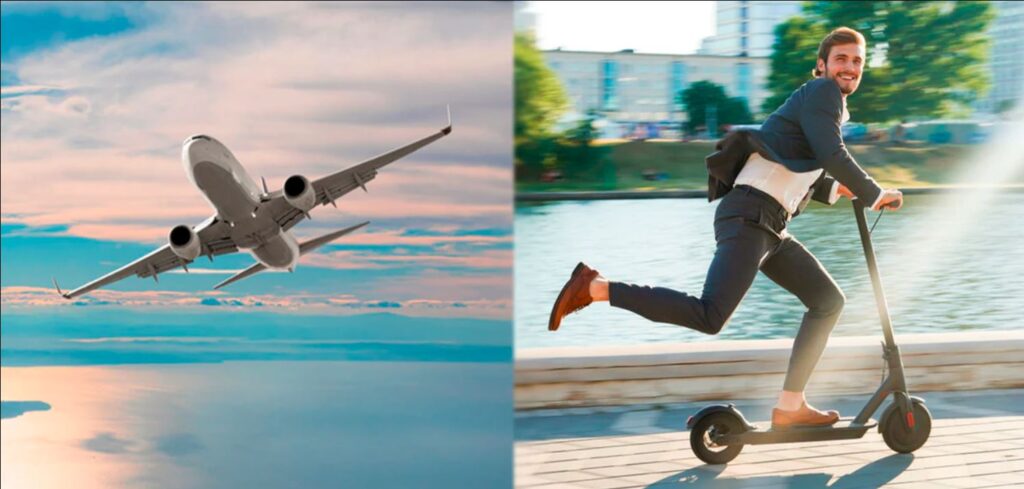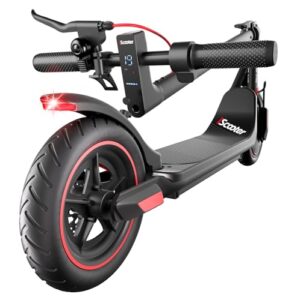Understanding the Challenges of Flying with an Electric Scooter
Electric scooters, while compact and convenient, pose unique challenges for air travel due to their lithium-ion batteries, which are classified as hazardous materials by aviation authorities like the Federal Aviation Administration (FAA) and the International Air Transport Association (IATA). These batteries can pose fire risks if damaged or improperly handled, making them a primary concern for airlines. Additionally, the size, weight, and intended use of the scooter (recreational vs. mobility aid) further complicate the matter. Below, we’ll break down the key factors that determine whether you can bring your electric scooter on a plane and how to navigate the process.
Key Factors Affecting Air Travel with Electric Scooters
- Battery Capacity (Watt-Hour Rating): The watt-hour (Wh) rating of the scooter’s lithium-ion battery is the most critical factor. Most airlines follow IATA and FAA guidelines, which categorize batteries as follows:
- Under 100 Wh: Generally allowed in carry-on or checked luggage without special approval.
- 100–160 Wh: May be allowed with prior airline approval, typically as carry-on only.
- Over 160 Wh: Prohibited in both carry-on and checked luggage for recreational scooters, with exceptions for mobility aids (up to 300 Wh in some cases).
Most recreational electric scooters have batteries exceeding 160 Wh, making them ineligible for air travel unless the battery is removable and meets these limits.
- Airline Policies: Each airline has its own rules regarding electric scooters, which may vary based on battery type, size, weight, and whether the scooter is a mobility aid. Some airlines outright ban recreational scooters, while others allow them under strict conditions.
- Scooter Size and Weight: Airlines impose size and weight restrictions for both carry-on and checked baggage. Most scooters are too large for overhead bins and must be checked, but they need to comply with baggage limits (typically 62 inches in combined dimensions and 50–70 pounds).
- Intended Use: Mobility scooters for passengers with disabilities often receive special allowances, such as higher battery capacity limits (up to 300 Wh) and exemptions from luggage allowances. Recreational scooters face stricter regulations.
- International vs. Domestic Flights: International flights often have more stringent rules due to varying customs regulations and IATA guidelines. Domestic flights in the U.S. follow FAA regulations but still vary by airline.
General Guidelines for Flying with an Electric Scooter
To determine if you can bring your electric scooter on a plane, follow these general guidelines based on FAA and IATA regulations, updated for 2025:
- Check Battery Capacity: Locate your scooter’s battery specifications (usually on the battery label or in the manual). Calculate the watt-hour rating using the formula: Wh = Voltage (V) × Amp-Hour (Ah). For example, a 36V, 5Ah battery equals 180 Wh, which exceeds most airline limits.
- Contact the Airline: Notify your airline at least 48 hours before your flight to confirm their policies. Provide details about the scooter’s make, model, battery type, and watt-hour rating.
- Remove the Battery: Most airlines require lithium-ion batteries to be removed and carried in the cabin as carry-on luggage, packed in a fireproof bag or with terminals taped to prevent short circuits.
- Pack the Scooter: Fold or disassemble the scooter to meet baggage size and weight limits. Use a protective case or original packaging to prevent damage during transport.
- Prepare Documentation: Carry the scooter’s manual or specification sheet, highlighting the battery type and capacity, to present at check-in or security.

Airline-Specific Policies for Electric Scooters in 2025
Airline policies vary widely, and staying informed about your carrier’s rules is crucial. Below is a summary of policies for major airlines, based on the latest available information as of July 28, 2025. Always verify with the airline directly, as policies may change.
American Airlines
- Policy: Recreational electric scooters with lithium-ion batteries are generally not permitted as carry-on or checked luggage due to safety concerns. Mobility scooters are allowed with prior approval from the Special Assistance team, provided the battery is removable and meets FAA/IATA limits (100 Wh without approval, 100–160 Wh with approval, or up to 300 Wh for mobility aids). The scooter must be checked as baggage and comply with size/weight limits (62 inches, 50 pounds).
- Preparation: Notify American Airlines 48 hours in advance. Remove the battery and carry it in a fireproof bag in the cabin. Label the scooter with your contact information.
- Tips: Provide detailed battery specifications and request written confirmation of approval to avoid issues at check-in.
Delta Airlines
- Policy: Delta allows electric scooters that comply with battery limits (under 100 Wh without approval, 100–160 Wh with approval). Mobility scooters may have batteries up to 300 Wh with prior approval. Scooters must be checked as baggage and meet size/weight restrictions. Batteries must be removed and carried in the cabin.
- Preparation: Contact Delta at least 48 hours before your flight (1 hour before domestic flights, 3 hours before international). Pack the scooter in a protective case and ensure the battery is properly labeled.
- Tips: Request wheelchair assistance if needed, as Delta provides support for passengers with mobility devices.
United Airlines
- Policy: Recreational electric scooters are not allowed, regardless of battery size, due to safety concerns. Mobility scooters are permitted as checked baggage with removable batteries (up to 300 Wh for one battery or 160 Wh each for two batteries). Batteries must be carried in the cabin in a fireproof bag.
- Preparation: Notify United 48 hours in advance. Ensure the scooter fits within checked baggage limits (62 inches, 50 pounds). Carry the battery in a non-conductive, fireproof bag.
- Tips: Request gate check-in for mobility scooters to retrieve them immediately upon landing.
Southwest Airlines
- Policy: Recreational electric scooters with lithium-ion batteries are prohibited. Mobility scooters with batteries under 300 Wh are allowed as checked baggage, with the battery removed and carried in the cabin.
- Preparation: Contact Southwest 48 hours prior to travel. Pack the scooter securely and label it. Remove the battery and tape terminals to prevent short circuits.
- Tips: Southwest does not count mobility scooters toward baggage allowances, so confirm this exemption when booking.
JetBlue Airways
- Policy: Recreational electric scooters are not permitted unless classified as mobility aids. Mobility scooters with batteries under 300 Wh are allowed as checked baggage, with batteries carried in the cabin.
- Preparation: Notify JetBlue 48 hours in advance. Provide battery specifications and ensure the scooter meets size/weight limits.
- Tips: Request gate check-in for easier retrieval at your destination.
Air Canada
- Policy: Small lithium battery-powered vehicles, including recreational electric scooters, are banned unless they are mobility aids. Mobility scooters with batteries up to 300 Wh are permitted as checked baggage, with batteries removed and carried in the cabin.
- Preparation: Contact Air Canada 48 hours before your flight. Use a protective case for the scooter and a fireproof bag for the battery.
- Tips: Check both departure and arrival country regulations for international flights.
Emirates
- Policy: Electric scooters must comply with IATA standards. Recreational scooters with batteries over 160 Wh are prohibited. Mobility scooters with batteries up to 300 Wh are allowed with prior approval. Batteries must be removed and carried in the cabin.
- Preparation: Notify Emirates 48 hours in advance. Provide battery specifications and ensure the scooter is packed securely.
- Tips: Emirates has strict size restrictions, so confirm dimensions with the airline.
British Airways
- Policy: Electric scooters are allowed as checked baggage if the battery is removable and under 300 Wh for mobility aids (100–160 Wh for recreational scooters with approval). The scooter must not exceed 32 kg per detached part.
- Preparation: Inform British Airways 48 hours before travel. Pack the scooter in a protective case and carry the battery in a fireproof bag.
- Tips: British Airways provides assistance for passengers with mobility scooters; request this when booking.
Ryanair
- Policy: Mobility scooters weighing up to 150 kg are permitted with pre-authorization. Batteries must be removable, with a limit of 300 Wh for one battery or 160 Wh each for two batteries. Recreational scooters face stricter limits (100–160 Wh with approval).
- Preparation: Notify Ryanair 48 hours in advance. Provide scooter and battery details, and pack the battery in a fireproof bag.
- Tips: Label the scooter clearly to avoid loss or damage.
Frontier and Allegiant
- Policy: Both airlines allow electric scooters with prior approval, provided the battery is under 160 Wh and removable. Frontier requires adherence to their dangerous goods policy, while Allegiant allows scooters for personal use without additional fees if batteries are securely attached.
- Preparation: Contact the airline 48 hours in advance. Remove the battery and carry it in a fireproof bag.
- Tips: Frontier may charge for oversized baggage, so confirm fees beforehand.
Preparing Your Electric Scooter for Air Travel
To ensure a smooth travel experience, follow these steps to prepare your electric scooter:
- Check Battery Specifications: Verify the watt-hour rating of your scooter’s battery. If it exceeds 160 Wh (or 300 Wh for mobility aids), it’s likely prohibited. For batteries between 100–160 Wh, secure airline approval.
- Notify the Airline: Contact the airline at least 48 hours before your flight to confirm their policies and request approval. Provide the scooter’s make, model, battery type, and watt-hour rating.
- Remove the Battery: Disconnect the battery and wrap it in non-conductive tape or place it in a fireproof lithium battery bag. Carry the battery in your carry-on luggage, as checked baggage is typically not allowed for lithium-ion batteries.
- Pack the Scooter: Fold or disassemble the scooter according to the manufacturer’s instructions. Use a hard-shell or padded travel case to protect it from damage. Ensure the scooter meets the airline’s size and weight limits (typically 62 inches and 50–70 pounds).
- Label Everything: Attach a tear-proof label to the scooter and battery with your name, contact information, and flight details to prevent loss.
- Remove Accessories: Detach loose items like phone holders, mirrors, or aftermarket lights to avoid damage or loss.
- Arrive Early: Allow extra time at the airport for check-in and security screening, as scooters may require additional inspection.
- Carry Documentation: Bring the scooter’s manual or specification sheet, highlighting the battery type and capacity, to present at check-in or security.
Special Considerations for Mobility Scooters
If your electric scooter is a mobility aid, you may benefit from more lenient regulations. The FAA and IATA allow mobility scooters with batteries up to 300 Wh (or two batteries up to 160 Wh each) for passengers with disabilities. Additional considerations include:
- Advance Notification: Inform the airline 48 hours in advance and request special assistance, such as wheelchair service to the gate.
- Gate Check-In: Many airlines allow you to use the scooter until the gate, where it’s tagged and stowed in the cargo hold. It’s returned at the arrival gate or baggage claim.
- Free Allowance: Mobility scooters typically don’t count toward baggage allowances, so confirm this with the airline.
- Recommended Models: Lightweight, foldable mobility scooters like the Monarch Air, SmartScoot, or TravelScoot are designed for air travel, with batteries under 300 Wh and easy disassembly.
Alternatives to Flying with Your Electric Scooter
If your scooter’s battery exceeds airline limits or the airline prohibits recreational scooters, consider these alternatives:
- Rent a Scooter at Your Destination: Many urban areas offer scooter-sharing services like Lime or Bird, or local rental shops for electric scooters. This eliminates the need to transport your own.
- Ship the Scooter: Use a courier or freight service (e.g., FedEx, DHL, or specialized transport companies) to ship your scooter to your destination. Note that lithium-ion batteries may still face shipping restrictions, so confirm with the provider.
- Sea Freight: For non-urgent travel, sea freight is a cost-effective option for shipping scooters, though it’s slower and requires compliance with international regulations.
- Use Public Transportation or Ride-Sharing: Rely on trains, buses, subways, or services like Uber and Lyft at your destination for convenient mobility.
- Purchase a Travel-Friendly Scooter: Invest in a lightweight, foldable scooter with a battery under 100 Wh (e.g., kids’ scooters or specific travel models like the Unagi Voyager) for easier air travel.
Tips for a Smooth Travel Experience
- Research Both Departure and Arrival Countries: International flights involve customs regulations that may differ from FAA/IATA rules. Check requirements for both countries to avoid issues.
- Get Everything in Writing: Request written confirmation of airline approval to avoid discrepancies at check-in.
- Use a Fireproof Bag: Invest in a lithium battery fireproof bag for safe battery transport. These are available on Amazon and comply with airline safety standards.
- Arrive Early: Allow at least 1 hour extra for domestic flights and 3 hours for international flights to handle check-in and security.
- Protect Your Scooter: Use a sturdy travel case and padding to prevent damage during handling. Label all parts clearly.
- Consider Insurance: Purchase travel insurance that covers valuable items like scooters in case of loss or damage.
Challenges and Future Outlook
The primary challenge with flying with electric scooters is the strict regulation of lithium-ion batteries, driven by safety concerns about thermal runaway and fire risks. In 2023 alone, the FAA recorded 60 lithium battery fires on commercial aircraft, underscoring the need for these restrictions. Most recreational scooters have batteries exceeding 160 Wh, making them ineligible for air travel. However, as electric scooter technology evolves, we may see more travel-friendly models with smaller batteries or safer battery chemistries (e.g., solid-state batteries) that could relax these restrictions in the future. Additionally, advocacy for standardized regulations across airlines could simplify the process for travelers.
Conclusion
Taking an electric scooter on a plane in 2025 is possible but requires careful planning and adherence to airline and regulatory guidelines. The key is to ensure your scooter’s battery is under 100 Wh (or 160 Wh with approval) for recreational scooters or 300 Wh for mobility aids, and to notify the airline at least 48 hours in advance. Always check airline-specific policies, pack the scooter and battery securely, and carry necessary documentation. If flying with your scooter isn’t feasible, alternatives like renting or shipping provide viable options. By preparing thoroughly and understanding the rules, you can enjoy the convenience of your electric scooter at your destination without the stress of airport surprises. Safe travels and happy riding!




